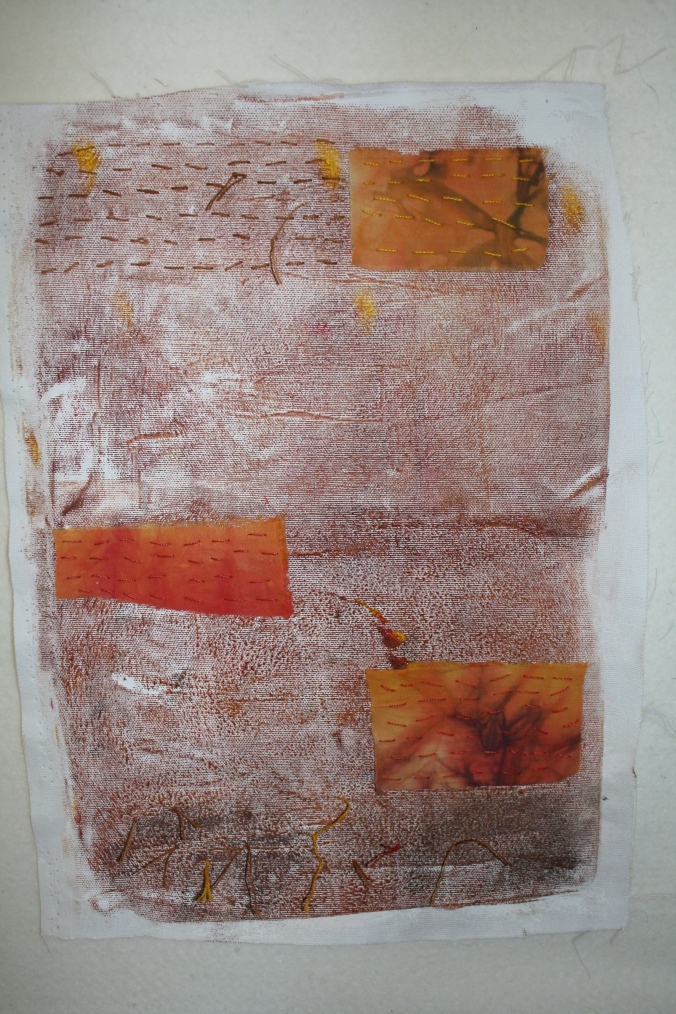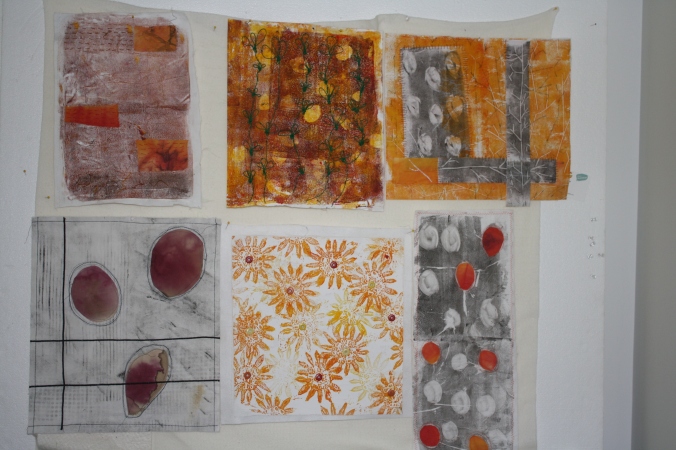In Assignment 5 I need to work to create a collection of at least six samples which do not have to be final but rather an opportunity to improve upon my experimental samples. The samples should be a minimum of 30cm by 30cm. I have interpreted this to mean that if something is rectangular than the total area must be in the vicinity of this measurement.
I have decided to confine my colour choices to orange/yellow/ochre/rust/ generally with black and white.
SAMPLE ONE
I wanted to take the mono printing approach further but to change the substrate I used in 5.3 experimental pieces as a further challenge to myself and to reflect in this first sample the delicate nature of the bougainvillaea flowers so I chose Art Tissue Paper as my substrate – it is very fine but strong and can be stitched into.
first I mono printed using the gelliplate and textile ink I drew with the back of a paint brush into the textile ink to depict the thorny nature of the plant. I then back printed in black textile ink the same thorny branches of the plant.
Next I painted my gelliplate with black textile ink and used a makeup wedge type sponge to remove paint to depict the bougainvillaea petals using once again the art tissue paper. This approach had the advantage of ensuring some paint was left to show interest in the actual petal and the papery type effect of using art tissue paper. I attached a section of the black and white petals mono print to white felt using bondaweb and then decided to adhere to my background ‘fabric’ which had also been attached with bondaweb to white felt. I decided to stitch the ‘petal piece’ to the background fabric using a primitive type stitch which in some way reflected the thorns on the plant. I was not happy with this piece as the petals dominated the work. So I mono printed some more paper fabric using a curvy type mark and auditioned it to the background piece see the series of photographs below I was not happy with any of these approaches. Next I thought more about my subject and decided I should depict further the thorny branches in a mono printed piece in combination. This did not work for me either it just looked like three pieces of fabric appliquéd on. So in the final piece I used the thorns in the vertical and horizontal and attached to the felt and then stitched using the same primitive straight stitch as I had used in the petals. I left some overhang at the bottom also.
SAMPLE ONE – FINAL PIECE size 37cm by 35cm
 SAMPLE TWO size 21cm by 51cm
SAMPLE TWO size 21cm by 51cm
I have once again chosen the Art Tissue Paper to mono print the petals of the bougainvillaea using black and white textile ink and my makeup sponge wedge for the petals. The gelliplate is a fixed size so I had to do more than one print to gain enough paper fabric to work with. I decided to use some of my procion hand dyed fabric (I dye fabric using low immersion technique and several dye colours so as to obtain interesting colour variations)which I freehand cut and appliquéd to several mono printed petals, I then machine outlined these petals using a number 50 weight machine cotton thread in orange. I used a haphazard type zigzag to sew around the edges to secure the paper fabric to white felt(which had been bondawebed). This piece captures the fragility of the bougainvillea petals and the colour.

SAMPLE THREE size 38cm by 38cm
In Part 5 Project 2 I undertook a series of pieces based on my chosen artist Georgia O’Keefe and in doing this influenced by her painting of “Sunflower” 1935 I carved a stamp using easy cut rubber and printed on newspaper. For Sample Three I have again taken this stamp and using variations in colour from yellow to deeper orange I have stamped the sunflower on canvas that I have covered in gesso (like my experimental pieces in 5.3 experimental pieces 2. I decided to go back to using eyelets like I have used in Part 4 yarns and in Part 5 yarns and place a similar colour eyelet in the middle of some of the stamped pieces. I did not want to do more work on this piece but mounted it on white felt. I think it has lots of movement and interest without adding even more embellishment. I think I am a minimalist at heart!
 SAMPLE FOUR -size 28cm by 38cm
SAMPLE FOUR -size 28cm by 38cm
This piece is designed to reflect the earth the bougainvillea grows in and the colours of the petals. I have mono printed with the gelliplate on canvas which has been gessoed using textile ink. I have rubbed earth (influence of Dorothy Caldwell – in my Research) from my garden into the bottom of the piece.
Why? My thoughts are I seem to be driven by the Part One exercise – Tropical Tourist and my further work in Part 5. I think that hose ‘talk’ to me I can relate to place where I live, my country, my State and colours and climate, to the peoples of this land – the Aboriginal peoples of my childhood – the colours of the earth and the contrasts of the bright hibiscus and bougainvillea, the bright greens, the yellow greens, – the sunlight – the blue of the sky. Our land and ancient peoples in Australia have a deep history. This has inspired me to want to do more earth dyeing and natural dyeing (my research piece on Sally Blake’s work with eucalyptus) and to research more on the basket and dilly bag making of the Aboriginal peoples. To consider free form weaving using these colours.
I have added some hand stitch to the colour squares and at the top and bottom I am still wondering if I should continue the stitching all over the piece I am not sure. Also whether to couch a red ochre thread in a loop I am not sure. Maybe the simplicity is enough.

SAMPLE FIVE size 36cm by 41cm
This piece is based on my photo in 5.2.3 yarns with the hibiscus flower which was past its flowering. I made the background using a piece of white linen and then printed directly onto the fabric using textile ink with a roller and underneath textures e.g. corrugated cardboard. I tea dyed some cotton with a herbal hibiscus and another flower teabag and some ordinary teabag this showed the decay that was starting to occur with the hibiscus flower petals. I free cut an dappliquéd the petal shapes onto the linen deliberately enhancing the size of the actual petals by about 100 percent. I considered how to add more depth to the piece and decided to attach by machine narrow textured ribbon in solid black. I then machine outlined the hibiscus petals using grey thread. I was not convinced the grey thread was standing out enough so added some more machine stitching using black thread. I attached the linen to white felt and machine stitched around the edges in black. I am still mulling over this piece I am not sure I have placed the appliqué shapes in the right order – should the biggest petal be in the righthand corner or should it have been place in the bottom left hand etc.

SAMPLE SIX – size 31 by 36 cm
You will recognise the extension of the sample I made in Part 5.3.2 experimental using canvas with white gesso. I again attempted to mono print using the bougainvillea petals and two layers and this time I achieved more contrast in the colours than in my sample. I wanted a rugged piece of background fabric because I wanted to use the wire yarn I had made in Part 5.2.4 of the bougainvillea leaves. I needed a fabric that would support the wire yarn. I pondered how to attach the yarn and tried staples (that did not work) and then thread. Using several strands of thread I could attach my yarn to the canvas. I am happy with this piece because I met my challenge to myself to use some experimental yarn as a design element in a fabric piece.
 Here is a photo of all the pieces up on my design wall (really just polystyrene and some thin batting!).
Here is a photo of all the pieces up on my design wall (really just polystyrene and some thin batting!).
 I will write my Written Reflection to Part Five in a following blogpost.
I will write my Written Reflection to Part Five in a following blogpost.




Wow! Really beautiful work, Rebecca. I love the combination of printing and stitch you’ve come up with. Sample Six is my favourite – but they are all lovely and I like the way you have displayed them on your design wall. It is interesting how the same course inspires us to come up with such a variety of outcomes.
LikeLike
Thank you very much Julia. It is exciting to see how we all interpret the required coursework.
LikeLiked by 1 person
Really wonderful, well done for reaching the end! I love your samples, the colours are great. Like Julia I think they look great displayed together- a true collection.
LikeLike
Thanks you so much Nicola. It has been a long journey!
LikeLiked by 1 person